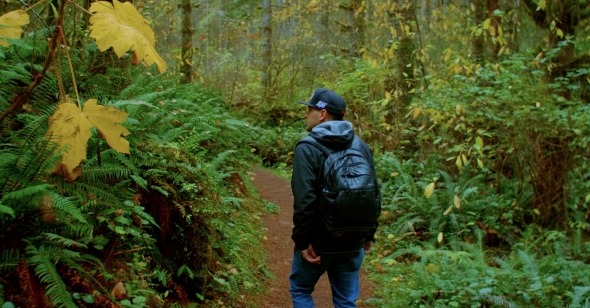The story of Maɬni – Towards the Ocean, Towards the Shore takes place in Portland, which I can only assume is the city in Oregon. However, it is framed very differently than a story about city people, or even someone who is trying to fit into society. Maɬni – Towards the Ocean, Towards the Shore is a story about indigenous people and how they carry themselves in their daily lives and why their environment is very important to them. The film focuses on Jordan and Sahme, who’s similarities are their connection to the ingenious people of the land and their role as parents, but beyond they have their differences.
The film opens with the audience following a man hiking through a forest, and it has dialogue that sounds completely different from anything that I’ve heard before. Later on, I discovered that the narrator was speaking Chinook, a language that the indigenous people of an area that is now modern-day Oregon and Washington speak. The narrator talks about moving towards the ocean and the shore, the movement in life, and how it influences life. We also shortly see Jordan driving a truck, assumingly leaving his place of work. Jordan is the first person that we see in the film and Jordan continues the theme of indigenous identity and talks Chinook as well. We see Jordan watching a baseball game and he takes about his people and his hair as a sign of identity. Jordan has a long braid, and he mentions that his people know what his long hair symbolizes. Shortly after, the viewers are introduced to Sahme, who presents a completely different dynamic than Jordan. The introduction is set up in a more natural environment, somewhere by a river, with very muddy banks. Sahme seems to be very in touch with nature, as this is presented as her natural environment. Surprisingly as a first in the film, Sahme speaks english, and what says is presented in Chinook subtitles. She is going through the wilderness, talking about her connection to the land and then the camera reveals that Sahme is expecting. Sahme clearly knows her way around the wilderness and we even see her later on standing under a small waterfall. Later in the film, the viewers are then peeking into the homes of Jordan and Sahme. Jordan’s house is much more lively with his family having fun in the background, and Jordan talks about his two children, Ila who was named after his grandma, and VIncent, the youngest of the two. Sahme talks about the impact of her environment and having her first born, since the land is connected to her own grandparents as well. Together they present the importance of the between life and death and how the land connects to our spirits. The film ends with Jordan canoeing to a very beautiful location with interesting lighting and Sahme devling back in similar scenery from when she was first introduced.

Between Jordan and Sahme, the viewers are introduced to the culture of Chinook method that’s not incredibly straight-forward. It’s almost like you have to pick apart their statements but also the many scenes of the film have different meanings and important details on what Chinook beliefs could be. Even though it makes sense for indigenious to be very involved with nature, nature is sprawling around the environments where Jordan and Sahme seem to have a stronger spiritual connection. This kind of ideology of who are and what the land is to us is very prominent in the film. The film talks about how we move towards the water, and we are walked through that journey, while also giving us insight on the importance of that journey and how that impacts those who are with us, those who are no longer with us, and those who are just beginning to exist. I struggle to see how is it experimental to be honest. For the most part it uses very familiar techniques with a few exceptions like when the footage was just a circle. I would say that the most experimental part about it is how we’re introduced to Jordan and Sahme. It feels very intimate and documentary style filming where we get close to the people that are at the center of the subject of the film. Although the most interesting thing that the film does is that it kind of code switches and gives us the entire film in Chinook. Even the prospect of whether there’s a film that is all Chinook is an interesting concept. It seems very natural to the film and very essential to the story. It makes the impact and connection stronger.